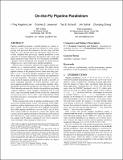On-the-fly pipeline parallelism
Author(s)
Lee, I-Ting Angelina; Leiserson, Charles E.; Sukha, Jim; Zhang, Zhunping; Schardl, Tao Benjamin
DownloadLeiserson_On-the-Fly.pdf (310.4Kb)
OPEN_ACCESS_POLICY
Open Access Policy
Creative Commons Attribution-Noncommercial-Share Alike
Terms of use
Metadata
Show full item recordAbstract
Pipeline parallelism organizes a parallel program as a linear sequence of s stages. Each stage processes elements of a data stream, passing each processed data element to the next stage, and then taking on a new element before the subsequent stages have necessarily completed their processing. Pipeline parallelism is used especially in streaming applications that perform video, audio, and digital signal processing. Three out of 13 benchmarks in PARSEC, a popular software benchmark suite designed for shared-memory multiprocessors, can be expressed as pipeline parallelism.
Whereas most concurrency platforms that support pipeline parallelism use a "construct-and-run" approach, this paper investigates "on-the-fly" pipeline parallelism, where the structure of the pipeline emerges as the program executes rather than being specified a priori. On-the-fly pipeline parallelism allows the number of stages to vary from iteration to iteration and dependencies to be data dependent. We propose simple linguistics for specifying on-the-fly pipeline parallelism and describe a provably efficient scheduling algorithm, the Piper algorithm, which integrates pipeline parallelism into a work-stealing scheduler, allowing pipeline and fork-join parallelism to be arbitrarily nested. The Piper algorithm automatically throttles the parallelism, precluding "runaway" pipelines. Given a pipeline computation with T[subscript 1] work and T[subscript ∞] span (critical-path length), Piper executes the computation on P processors in T[subscript P]≤ T[subscript 1]/P + O(T[subscript ∞] + lg P) expected time. Piper also limits stack space, ensuring that it does not grow unboundedly with running time.
We have incorporated on-the-fly pipeline parallelism into a Cilk-based work-stealing runtime system. Our prototype Cilk-P implementation exploits optimizations such as lazy enabling and dependency folding. We have ported the three PARSEC benchmarks that exhibit pipeline parallelism to run on Cilk-P. One of these, x264, cannot readily be executed by systems that support only construct-and-run pipeline parallelism. Benchmark results indicate that Cilk-P has low serial overhead and good scalability. On x264, for example, Cilk-P exhibits a speedup of 13.87 over its respective serial counterpart when running on 16 processors.
Date issued
2013-07Department
Massachusetts Institute of Technology. Computer Science and Artificial Intelligence Laboratory; Massachusetts Institute of Technology. Department of Electrical Engineering and Computer ScienceJournal
Proceedings of the 25th ACM symposium on Parallelism in algorithms and architectures (SPAA '13)
Publisher
Association for Computing Machinery (ACM)
Citation
I-Ting Angelina Lee, Charles E. Leiserson, Tao B. Schardl, Jim Sukha, and Zhunping Zhang. 2013. On-the-fly pipeline parallelism. In Proceedings of the twenty-fifth annual ACM symposium on Parallelism in algorithms and architectures (SPAA '13). ACM, New York, NY, USA, 140-151.
Version: Author's final manuscript
ISBN
9781450315722